
In this lesson, students integrate information from two texts on the same topic.
- Subject:
- English Language Arts
- Material Type:
- Lesson Plan
- Provider:
- EngageNY
- Author:
- Engage NY
- Date Added:
- 04/23/2014

In this lesson, students integrate information from two texts on the same topic.
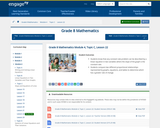
In this lesson, students know that any constant rate problem can be described by a linear equation in two variables where the slope of the graph is the constant rate. Students compare two different proportional relationships represented by graphs, equations, and tables to determine which has a greater rate of change
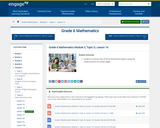
In this lesson, students construct nets of three-dimensional objects using the measurements of a solid’s edges.
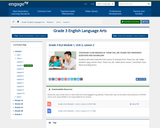
In this lesson from Expeditionary Learning, students will perform a close reading of Thank You, Mr. Falker by Patricia Polacco. They will answer questions using specific details from the text and explain why they chose those details. Students will also use context clues to access new vocabulary. This is Lesson 2 of 10 from the unit Grade 3 Curriculum Map Unit 2, Module 1: http://engageny.org/resource/grade-3-ela-module-1-unit-2 .
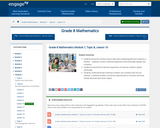
For this lesson, students know the intuitive reason why every repeating decimal is equal to a fraction. Students convert a decimal expansion that eventually repeats into a fraction. Students know that the decimal expansions of rational numbers repeat eventually. Students understand that irrational numbers are numbers that are not rational. Irrational numbers cannot be represented as a fraction and have infinite decimals that never repeat.
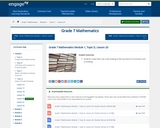
In this lesson, students create their own scale drawing of the top-view of a furnished room or building.
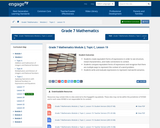
In this lesson, students create equivalent forms of expressions in order to see structure, reveal characteristics, and make connections to context. Students compare equivalent forms of expressions and recognize that there are multiple ways to represent the context of a word problem. Students write and evaluate expressions to represent real-world scenarios.

Students will be able to interpret word problems to create equations in one variable and solve them (i.e., determine the solution set) using factoring and the zero product property
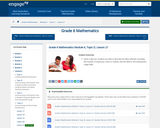
In this lesson, students are given a data set to describe the data collected, including the number of responses, mean or median, and the MAD or the interquartile range (IQR).
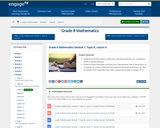
Students know that every number has a decimal expansion (i.e., is equal to a finite or infinite decimal). Students know that when a fraction has a denominator that is the product of 2’s and/or 5’s, it has a finite decimal expansion because the fraction can then be written in an equivalent form with a denominator that is a power of 10.
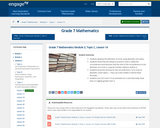
In this lesson, students develop the definition of circle using diameter and radius. Students know that the distance around a circle is called the circumference and discover that the ratio of the circumference to the diameter of a circle is a special number called pi, written π. Students know the formula for the circumference C of a circle of diameter d and radius r. They use scale models to derive these formulas. Students use 22/7 and 3.14 as estimates for π and informally show that π is slightly greater than 3.
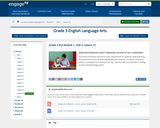
In this lesson, students demonstrate fluencey when reading stories or poems for audio recording.
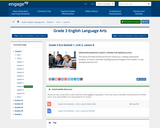
In this lesson, students demostrate fluency when reading stories or poems for an audio recording.
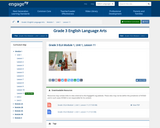
In this lesson, students describe characters in a story and describe how a character's actions contribute to the events in the story.
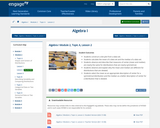
Students construct a dot plot from a data set; Students calculate the mean of a data set and the median of a data set; Students observe and describe that measures of center (mean and median) are nearly the same for distributions that are nearly symmetrical; Students observe and explain why the mean and median are different for distributions that are skewed; Students select the mean as an appropriate description of center for a symmetrical distribution and the median as a better description of center for a distribution that is skewed.

Students will develop a set of tools for understanding and interpreting variability in data, and begin to make more informed decisions from data. They work with data distributions of various shapes, centers, and spreads. Students build on their experience with bivariate quantitative data from Grade 8. This module sets the stage for more extensive work with sampling and inference in later grades.
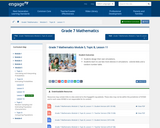
In this lesson, students design their own simulations. Students learn to use two more devices in simulations: colored disks and a random number table.
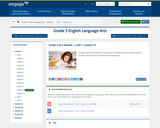
In this lesson, students answer questions using specific details from the text and determine the meaning of new vocabulary using clues in the text around a word.
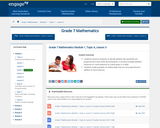
In this lesson, students examine situations to decide whether two quantities are proportional to each other by checking for a constant multiple between measures of x and measures of y when given in a table. Students study examples of relationships that are not proportional in addition to those that are.
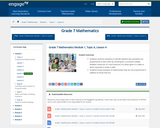
In this lesson, students examine situations to decide whether two quantities are proportional to each other by checking for a constant multiple between measures of x and measures of y when given in a table or when required to create a table. Students study examples of relationships that are not proportional in addition to those that are.